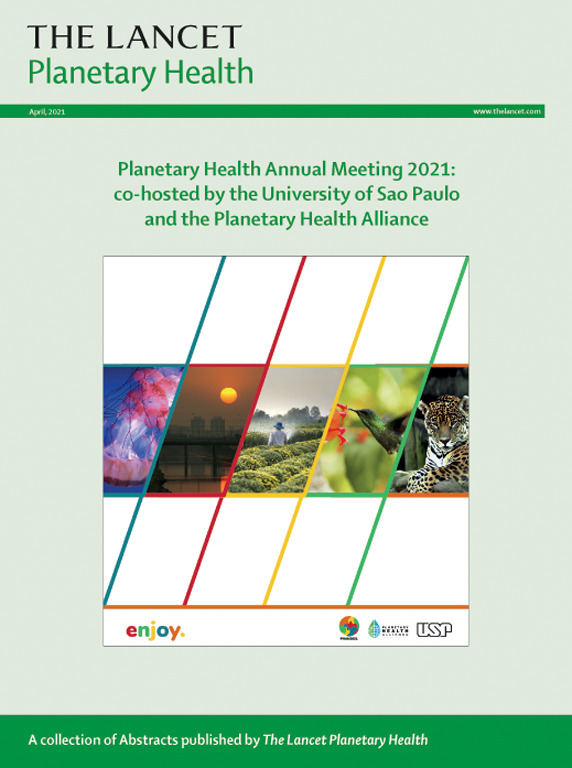估算由绿化引起的城市热相关死亡率负担:一项全球模型研究。
IF 21.6
1区 医学
Q1 ENVIRONMENTAL SCIENCES
引用次数: 0
摘要
背景:热暴露对公众健康构成重大威胁。增加绿化已被建议作为一种缓解策略,因为它具有冷却效果和改变热死亡率关联的潜力。这项研究旨在全面估计绿化增加对热相关死亡的影响。方法:我们采用多阶段荟萃分析方法来估计2000-19年暖季增加11,534个城市地区的绿化对全球热相关死亡的潜在减少。我们使用增强植被指数(EVI)来表示绿度,并使用随机森林模型来预测反事实EVI情景下的日温度。在实际EVI情景中,从多国多城市合作研究网络中提取53个国家830个地点的日死亡率和天气变量,并用于评估热死亡率关联。然后,基于元回归模型,将这些关联外推到每个城市在事实和反事实EVI情景下。结果:EVI每增加10%,全球人口加权暖季平均气温将降低0.08℃;EVI每增加20%,全球人口加权暖季平均气温将降低0.14℃;EVI每增加30%,全球人口加权暖季平均气温将降低0.19℃。在实际情景中,127 179 341例死亡中有3 153 225例(2.48%)可归因于热暴露。与事实情景相比,2000-19年热相关死亡的归因比例(占总死亡的比例)在10%情景中下降0.67(95%经验CI 0.53 - 0.82)个百分点,在20%情景中下降0.80(0.63 - 0.97)个百分点,在30%情景中下降0.91(0.72 - 0.10)个百分点。南欧的模型显示,热相关死亡率的可归因比例下降幅度最大。解释:该模型研究表明,绿化的增加可以大大减少与热有关的死亡率负担。保持和扩大绿化可能是降低环境温度和减少热暴露对健康影响的潜在策略。资助:澳大利亚研究理事会和澳大利亚国家卫生和医学研究理事会。本文章由计算机程序翻译,如有差异,请以英文原文为准。
Estimating the urban heat-related mortality burden due to greenness: a global modelling study
Background
Heat exposure poses a substantial public health threat. Increasing greenness has been suggested as a mitigation strategy due to its cooling effect and potential to modify the heat–mortality association. This study aimed to comprehensively estimate the effects of increased greenness on heat-related deaths.
Methods
We applied a multistage meta-analytical approach to estimate the potential reduction in global heat-related deaths by increasing greenness in the warm season in 2000–19 in 11 534 urban areas. We used the enhanced vegetation index (EVI) to indicate greenness and a random forest model to predict daily temperatures in counterfactual EVI scenarios. In the factual EVI scenarios, daily mortality and weather variables from 830 locations in 53 countries were extracted from the Multi-Country Multi-City Collaborative Research Network and used to assess heat–mortality associations. These associations were then extrapolated to each urban area under both factual and counterfactual EVI scenarios based on meta-regression models.
Findings
We estimated that EVI increased by 10% would decrease the global population-weighted warm-season mean temperature by 0·08°C, EVI increased by 20% would decrease temperature by 0·14°C, and EVI increased by 30% would decrease temperature by 0·19°C. In the factual scenario, 3 153 225 (2·48%) of 127 179 341 total deaths could be attributed to heat exposure. The attributable fraction of heat-related deaths (as a fraction of total deaths) in 2000–19 would decrease by 0·67 (95% empirical CI 0·53–0·82) percentage points in the 10% scenario, 0·80 (0·63–0·97) percentage points in the 20% scenario, and 0·91 (0·72–1·10) percentage points in the 30% scenario, compared with the factual scenario. South Europe was modelled to have the largest decrease in attributable fraction of heat-related mortality.
Interpretation
This modelling study suggests that increased greenness could substantially reduce the heat-related mortality burden. Preserving and expanding greenness might be potential strategies to lower ambient temperature and reduce the health impacts of heat exposure.
Funding
Australian Research Council and Australian National Health and Medical Research Council.
求助全文
通过发布文献求助,成功后即可免费获取论文全文。
去求助
来源期刊

Lancet Planetary Health
Multiple-
CiteScore
28.40
自引率
2.30%
发文量
272
审稿时长
8 weeks
期刊介绍:
The Lancet Planetary Health is a gold Open Access journal dedicated to investigating and addressing the multifaceted determinants of healthy human civilizations and their impact on natural systems. Positioned as a key player in sustainable development, the journal covers a broad, interdisciplinary scope, encompassing areas such as poverty, nutrition, gender equity, water and sanitation, energy, economic growth, industrialization, inequality, urbanization, human consumption and production, climate change, ocean health, land use, peace, and justice.
With a commitment to publishing high-quality research, comment, and correspondence, it aims to be the leading journal for sustainable development in the face of unprecedented dangers and threats.
 求助内容:
求助内容: 应助结果提醒方式:
应助结果提醒方式:


